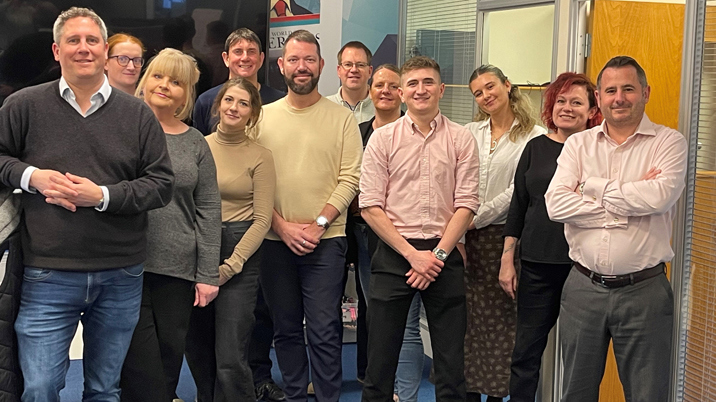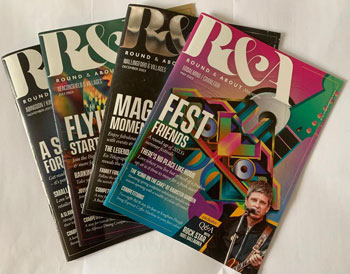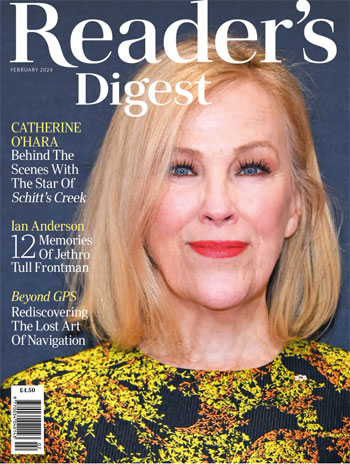
Pity the poor postman on publication day.
Round & About publishes 31 local magazines distributing 609,000 copies monthly. That’s 7.3m items a year – all put through your letterbox by Royal Mail.
It’s part of what makes this innovative publisher stand out from the crowd and has helped them prosper in a difficult marketplace to chalk up 30 years in print this April.
The concept is neat and straightforward. A convenient sized (just a bit bigger than A5) colour glossy magazine full of local content, both editorial and advertising, delivered directly to customers in discrete postcodes within a maximum of 64 pages, which is the postage weight limit.

The original and first edition was Wallingford & Didcot (Oxfordshire) back in April 1994 and it is now joined by its 30 neighbours in six counties. “Conquering the world, postcode by postcode,” is how managing director Chris Savage puts it.
Revenues have grown seven per cent this year, partly driven by new launches, but Chris maintains that revenues remain strong because they are committed to print.
“We are all very committed to print, and perhaps unlike some other regional publishers, our circulation numbers are very real, as it’s led by the number of homes within a postcode, provided by Royal Mail, and we are always very happy and open to prove our numbers,” says Chris.
“The route to market is a very key part to our offering. Our other key component is our ‘Spotlight’ column which publicises not-for-profit community events, fund raisers, societies and happenings for free. In essence, it’s by the people, for the people.”
Launch
It was Chris’s father, Peter, who started Round & About after working for Reader’s Digest (see separate panel) and predicting an appetite for a similar easy read, comfortable format publication, but with a local focus.
That was in April 1994, and the 14-year-old Chris was advised by his mother not to go into publishing. But via a friend and a recruitment agency, he soon started at Haymarket and was then running his own ventures.
“I’d started something in France but was hit by the global crash of 2009 and my wife was pregnant, so we came home. My dad said, ‘Look, I'm fed up with these recessions. Why don’t you have a go?’ So, I took the helm in 2010 and I’ve been here ever since.”
Here is now a bright and vibrant office on a business park in the outskirts of Wallingford in Oxfordshire, perfectly placed to service the 31 editions across six neighbouring counties. Everything is done in-house by a full-time staff of 20. Peter passed away in 2022 but was involved until the day he died.
A range of advertisers from the national (Specsavers plus an eye test voucher), regional with replacement windows, drain clearing and entertainment events, through to the local covering oven cleaners, gardeners and interior design.
It’s not trying to be a services directory but anything that has local pest control, emergency plumbers and PC repairs has got to be worth its place on the telephone table, if that’s still a thing.
The classified listing is still a vital part of the magazine, Chris maintains. “Yes, it’s stronger in some areas than others, but essentially, it’s an affordable way to advertise and people know straight away what they’re doing when they go to a classified section and others aren’t doing it. And it kind of sets us apart again.”
At £29 per edition for up to 14 words, and just 50p for additional words, it’s easy to see why hypnotherapist Paul and plasterer Mark find it a good place to be.
The mix of collated community events, things to see and do, music and theatre plus interviews and eating out seems to hit the spot. There’s a ‘celebrity’ Q&A every issue too – December’s revealing that TV farmer Kaleb Cooper and, er, TV farmer Jeremy Clarkson argue incessantly and, “I’m right and he’s wrong every time…”
Two former newspaper journalists wrangle predominantly submitted local content into readable sections, especially that ‘Spotlight on…’ which collates community events and activities. Who could resist an evening with Gillie Scarrott-Jones and her crystal skulls at the Waverley Dowsers Society?
A team effort
Each department in the company plays its part, and Chris is keen to create a team ethos, with everyone now expected back in the office full time.
“Without the editorial, we wouldn’t have readers. Without the robust and large distribution, it wouldn’t get read and without both of those, advertising sales wouldn’t flourish. And, of course, without our accounts department, we wouldn’t have the money to trade. So, with a commitment to being back in the office and working for each other, we have flourished since the tough early days of Covid, where we continued to publish.
“Our publishing model is an obvious one perhaps to national magazines. However, all too often on a local level, something gets sacrificed. If you want high end glossy, you sacrifice print runs. For a good distribution, editorial is left wanting and for speed and efficiency, design is an off-the-peg template. I hope, with all skills being in-house, we have all the key elements for success. Although, like most publishers right now, we would always love to be on heavier stock paper…
“It is very much a team effort, and a team that still loves print. Here’s hoping our readers will continue to do so for many years to come.”
Print v Digital
Of course, the elephant in the room for many community publishers is ‘print v digital’ or, more accurately, print and digital.
An online presence has swiftly gone from a nice-to-have to a must-have, but how much resource should be dedicated to developing online, maybe at the expense of the more expensive, albeit successful, print products?
Round & About publishes a natty email newsletter with well-written links to content on the website, some competitions and an invite to ‘Download the free app’. The app is neatly put together and even comes with a polite ‘Welcome to the Community Space’ with an invite to send suggestions for improving the app (none from me at the moment, thanks).
Interestingly, the jury is still out for the Round & About app. “We launched the app last year and the feedback is actually, people don’t want another app,” says Chris. “They thought it would be the end of print and we’ve got a lot of stick – people are frustrated with the fact that that we’re forcing them to use an app to a degree.”
Like many successful print publishers, Chris is keeping a close eye on digital developments. “There’s a little bit of probably seeing how it all pans out with the internet, but equally, I don’t want to be the person that sits in the room and says, did not see that coming.”
Chris has indeed seen it coming and is relaunching the website to bring it up to speed and make it a bit more user friendly. “AI is obviously a big threat for lots of reasons. But like everyone, we want to gather some information and build a supportive sort of database off the back of it. So, I guess that’s the angle and the area we’ll go to.
“Every day, you hear about print being at the end of its life. But radio wasn’t killed off by TV and here we are. The internet has obviously changed print but you’re now seeing a lot of publications come back into print. And I think that’s because we’re learning to adjust again to the fact that there is time for magazines and there’s also a place for digital which is at the touch of a button.
“We also haven’t chased the internet sales or divested to sell digital products and packages. That said, of course, we are keeping a close eye on what is going on with regional news and community platforms, but nothing as yet suggests revenues from print can be replaced by digital sales at this local level, but that will no doubt evolve. We do generate some digital revenue, something we’re building on, but very much as a partner to print rather than an alternative.”
Reader’s Digest: “A form of the internet before it even existed”
Reader’s Digest – ‘the world at your fingertips’ or ‘100 years of bringing you the best stories, guides, advice and jokes’ or ‘small, but perfectly informed’ – has had more than 100 years to perfect its tagline and now also claims to be ‘the largest circulating magazine in the world’.

Once a staple of doctors’ waiting rooms and your grandma’s coffee table with its homespun tales and dad jokes, it has a history in the UK going back to 1938 following the US launch in 1922. And it’s still going strong, although like, Round & About, it too is wrestling with a digital future.
“We are living in age of information. Click your fingers (or click a button) and you can find the answer to almost any question,” says a message on their website.
“Research suggests, however, that this information overload isn't making us happier. Quite the opposite, in fact it’s making us more stressed and more cynical. Reader’s Digest was, in effect, a form of the internet before it even existed. It was a compendium of the best advice, the best stories and a way of connecting people through common interests. The difference was that it was a medium you could trust – and you still can.
“We also want to be a respite for your mind. In picking up a copy of Reader’s Digest, you can get away from the clickbait, the sensationalism and constant updates – and lose yourself in quality. Whether reading our print or online articles, Reader’s Digest gives you the chance to have a quiet moment, learn about an interesting topic, and come away better-off for it.”
Invest just £4.50 on the newsstand and all that can be yours…
This article was first published in InPublishing magazine. If you would like to be added to the free mailing list to receive the magazine, please register here.












